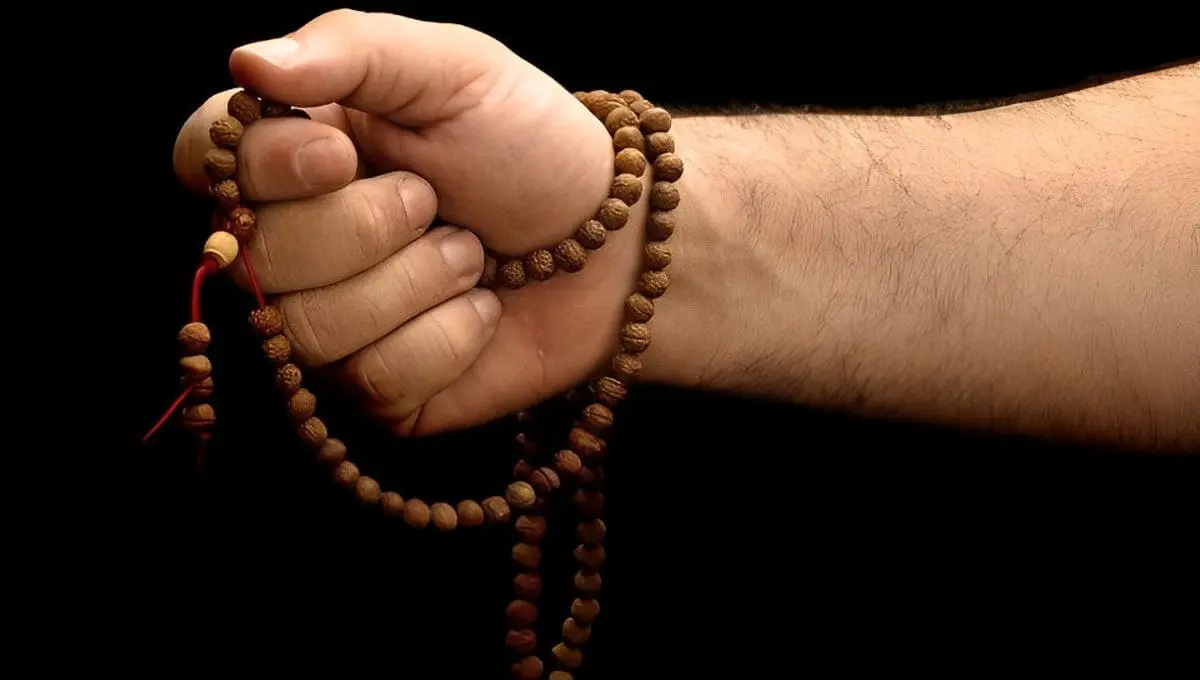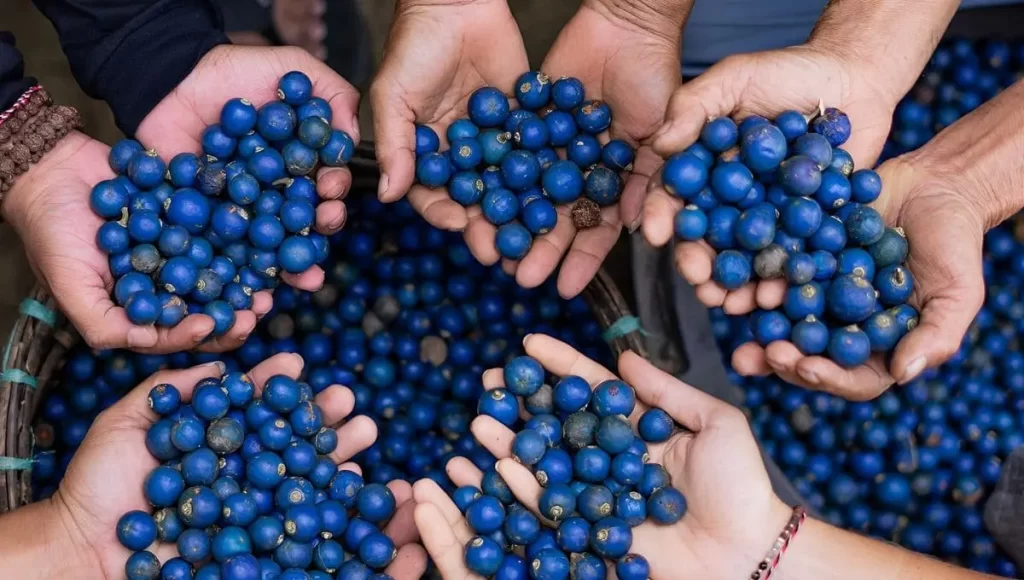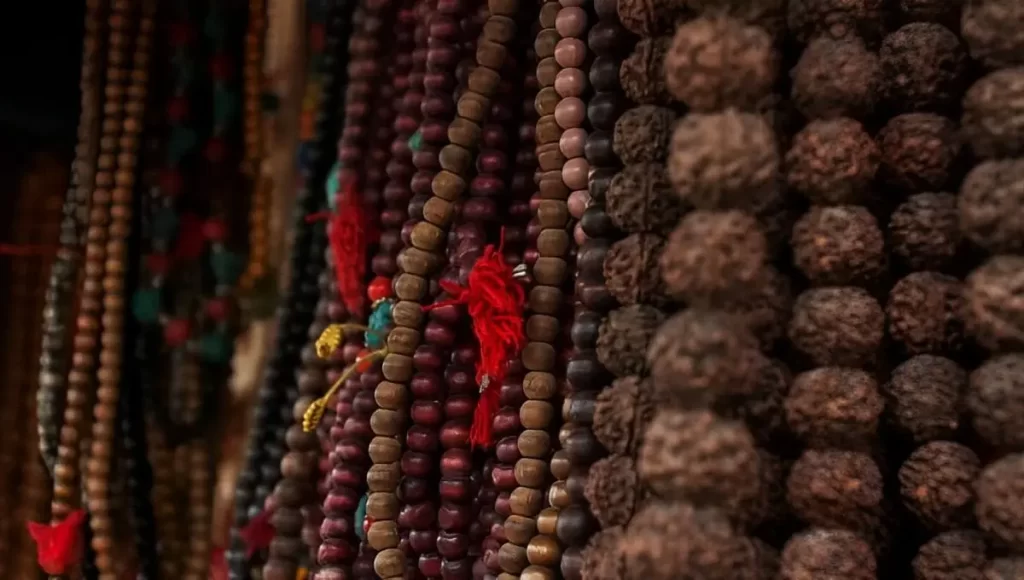
Rudraksha: Immortal Beads of Lord Shiva
Immortal Beads of Lord Shiva: The name “Rudraksha” is derived from the combination of two Sanskrit words, “rudra” which means Lord Shiva, and “aksha,” meaning eyes. Rudraksha, also known as the “tears of Lord Shiva,” is a spiritual seed that holds immense significance in Hinduism. This bead-like fruit grows on the evergreen Elaeocarpus ganitrus tree, found mainly in the Himalayan regions of India, Nepal, and Indonesia.
The significance of this holy bead has been mentioned in various ancient scriptures like the Puranas, Shiva Purana, and Devi Bhagavatam, making it a powerful spiritual tool for meditation and healing. Wearing or using Rudraksha is believed to bring peace, prosperity, and divine blessings to the wearer, and has been embraced by spiritual seekers around the world for its powerful benefits. In this article, we will explore the origins, characteristics, uses, benefits and importance of Rudraksha in detail.
ORIGIN OF RUDRAKSHA

The origin of Rudraksha is believed to be rooted in Hindu mythology. According to legend, Lord Shiva, one of the major deities in Hinduism, once went into deep meditation for thousands of years. When he opened his eyes, tears fell from them and landed on the earth, creating Rudraksha trees. The word “Rudraksha” comes from the Sanskrit words “Rudra,” which means “Lord Shiva,” and “Aksha,” which means “tears.”
The Elaeocarpus ganitrus tree, which produces the Rudraksha seed, is primarily found in the foothills of the Himalayas, as well as other parts of India, Nepal, and Indonesia. The seeds are harvested from the tree and are considered sacred objects in Hinduism.
Rudraksha is mentioned in ancient Hindu scriptures, including the Shiva Purana and the Padma Purana, and is considered a powerful and important tool for spiritual development and well-being. It is believed that wearing or using Rudraksha can help individuals connect with the divine, enhance their spiritual awareness, and promote physical and emotional healing.
Today, Rudraksha is widely used and accepted in Hindu culture and is considered an important symbol of spiritual devotion and practice. It is also gaining popularity in other parts of the world, with many people using Rudraksha malas and other accessories for their spiritual and health benefits.
CHARACTERISTICS OF RUDRAKSHA
According to scientific studies, rudraksha beads possess some electrical and magnetic properties. Additionally, according to researchers, rudrakshas with different faces have different elecromagnetic characteristics. Carbon, hydrogen, nitrogen, and a few trace elements make up rudraksha beads. There are 108 different faces for rudraksha beads, however currently only 2 to 21 are offered in common. While single faced rudraksha seeds are rarely available, some say that 22 to 108 face rudraksha plants can still be found in the mansarovar and himalayan foothills.
A big, broad-leaved evergreen tree, rudraksha. The family is TILLIACEAE, and the scientific name for it is ELAEOCARPUS GANITRUX ROXUB. Its habitat ranges from the seashore up to 2,000 meters in altitude. Geographically, tropical and subtropical regions are where it grows naturally and in great abundance. In their habitat, trees are perennial. The trees range in height from from 50 to 200 feet.
The seeds come in four different colors. White, followed by reddish, then golden, and finally dark, are the most searched colors. Their conventional order of excellence is not based on rarity because the first and third types are unusual while the other two are common.
A seed has a soft core through which a threading hole is punched.
This core’s surface is separated into several crescent-shaped portions by a number of lines that go over it from end to end. The most typical type of bead has five pieces, however there can be one to fourteen.
According to Yoga Sara, the number of parts or “faces” in the beads indicates the kind of mantra that is most suited for them. Spiritual qualities belonging to the gods are said to abide in the beads in accordance with these numbers.
- Shiva idolizes bead with just one face.
- Shiva and his Shakti Parvati idolizes bead with two face.
- Agni, the God of Fire idolizes bead with three face.
- Brahma, the God of creation idolizes bead with four face.
- Yama the God of Death idolizes bead with five face.
- Sunbrahmanya or Skanda also known as Karthikeya son of lord Shiva and Parvati, idolizes bead with six face.
- Adishesha the Anant Shesha idolizes bead with seven face.
- Ganpati, son of lord Shiva and Parvati, idolizes bead with eight face.
- Bhairava, that is Shiva in his ferocious form idolizes bead with nine face.
- Vishnu the God of Preservation idolizes bead with ten face.
- Ekdasa Rudras, which is Eleven Rudas idolizes bead with eleven face.
- Surya the God of the Sun idolizes bead with twelve face.
- Kamdev, the God of Love idolizes bead with thirteen face.
- Nilakantha that is Shiva the Blue-Throated idolizes bead with fourteen face.
According to the ancient legend “Shiva Purana,” Rudraksha trees are said to grow in Gouda Land, which is currently the Gangetic Plain area on the southern border of Asia to the foothills of the Great Himalaya and central region of Nepal. Its habitat thus stretches from Manila to Bengal, Assam, and neighboring north-eastern states, Bangladesh, Bhutan, and Nepal after crossing via Myanmar, plains, and low hills. Rudraksha trees are primarily found in Nepal and the southern region of Asia nowadays.
USES OF RUDRAKSHA

Rudraksha is a powerful spiritual tool that can be used in various ways to enhance one’s physical, mental, and spiritual well-being. Some of the common uses of Rudraksha are:
Meditation: Wearing or holding Rudraksha beads during meditation helps in calming the mind and deepening the spiritual experience. It helps in increasing focus, concentration, and energy, and promotes a sense of inner peace and harmony.
Healing: Rudraksha beads are believed to have therapeutic properties and can be used to reduce various physical and mental condition. It is said to have a positive effect on the nervous system, reducing stress, anxiety, and depression.
Protection: Wearing Rudraksha beads is believed to provide protection from negative energies, evil spirits, and black magic. It helps in building a protective shield around the wearer and promotes a sense of inner strength and courage.
Manifestation: Rudraksha beads are also used for manifesting desires and intentions. Each bead is associated with a particular deity or energy, and wearing specific Rudraksha combinations can help in attracting specific energies and manifesting one’s desires.
Astrology: Rudraksha beads are widely used in Vedic astrology as a remedy for planetary afflictions. Wearing specific Rudraksha beads is believed to balance the energies of the planets and bring favorable results.
Overall, Rudraksha is a versatile spiritual tool that can be used in various ways to enhance one’s life and spiritual growth.
BENEFITS OF RUDRAKSHA BEADS AND LOCAL ACCEPTANCE
In Hinduism, Rudraksha is considered a sacred object and is often worn as a bead necklace or bracelet. It is believed to have numerous benefits, both spiritual and physical, and is said to enhance one’s well-being and spiritual development.
Some of the benefits of Rudraksha are:
Spiritual benefits: Wearing Rudraksha is believed to increase one’s spiritual awareness and connect them with the divine. It is also said to enhance meditation and promote a sense of inner peace.
Health benefits: Rudraksha is said to have a positive impact on the nervous system, and can help lower blood pressure, reduce stress and anxiety, and improve concentration.
Protection: Rudraksha is believed to have protective qualities and is said to ward off negative energies and entities.
In terms of local acceptance, Rudraksha is widely accepted and respected in Hinduism and is used by both religious and non-religious individuals. It is often worn as a fashion accessory as well as for its spiritual and health benefits. In India, Nepal, and other regions where Rudraksha is commonly found, it is readily available for purchase in markets and spiritual shops. Overall, Rudraksha is an important part of Hindu culture and is widely recognized for its positive effects on well-being and spirituality.
IMPORTANCE OF RUDRAKSHA MALA
Rudraksha malas are a traditional tool used for spiritual practices, meditation, and prayer in Hinduism. A mala is a string of prayer beads, typically made of 108 beads, that is used to keep count of recitations or mantras during meditation or prayer.

Rudraksha malas are considered particularly important in Hinduism because they are believed to have special spiritual and healing properties. The number and type of Rudraksha beads used in a mala can vary depending on the specific intention of the practitioner. The beads are typically strung on a silk or cotton cord and can be worn as a necklace or wrapped around the wrist.
Some of the benefits of using a Rudraksha mala during meditation or prayer include:
- Enhancing spiritual awareness and connection with the divine.
- Promoting a sense of inner peace and calm.
- Improving concentration and focus during meditation.
- Providing protection against negative energies and entities.
- Supporting physical and emotional healing.
Rudraksha malas are also used as a fashion accessory, with many people wearing them as a necklace or bracelet for their unique and beautiful appearance. However, the spiritual benefits of Rudraksha malas make them an important tool for many practitioners of Hinduism and other spiritual practices.
ALSO READ:
